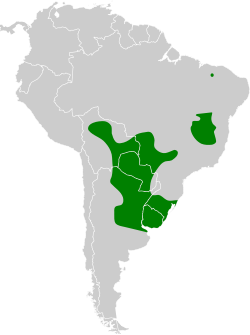Description
The chotoy spinetail is 20 to 22 cm (7.9 to 8.7 in) long and weighs 15 to 22.5 g (0.53 to 0.79 oz). It is a large spinetail with a unique throat pattern. The sexes have the same plumage. Adults of the nominate subspecies have a white supercilium and light brown ear coverts. Their forehead is dark brown, their crown chestnut with faint brown streaks, their back sandy brown with obvious dark brown streaks, and their lower back, rump, and uppertail coverts light brown. Their wings are mostly light brown with a chestnut shoulder. Their tail is long and light brown with blackish feather shafts. Their chin and upper throat are bright yellow; the lower throat is a crisp black square surrounded by white. Their upper breast is apricot, their lower breast buffy white, their belly whitish, their flanks brownish buff, and their undertail coverts rufescent buff. Their iris is red to brown, their maxilla blackish to dark gray, their mandible gray to bluish (sometimes with a dark tip), and their legs and feet light gray to brownish. Juveniles have less sharp streaking on their uppersides than adults, a brown crown, a whitish chin, and an indistinct black throat patch. Subspecies S. p. petersi has plumage like the nominate's but is smaller. [4] [8] [9]
Distribution and habitat
The nominate subspecies of the chotoy spinetail is by far the more widespread of the two. It is found in eastern Bolivia, Mato Grosso do Sul and Rio Grande do Sul in Brazil, most of Paraguay, northeastern Argentina as far south as northern Buenos Aires Province, and essentially all of Uruguay. Subspecies S. p. petersi is found disjunctly in northeastern Brazil's states of Minas Gerais, Bahia, and far separated in Piauí. The species inhabits a variety of open to semi-open landscapes including treed savanna; gallery forest, thickets, and scrub along watercourses; monte woodlands; and the edges of marshes. In elevation it ranges from near sea level to 500 m (1,600 ft). [4] [8] [9]
This page is based on this
Wikipedia article Text is available under the
CC BY-SA 4.0 license; additional terms may apply.
Images, videos and audio are available under their respective licenses.





